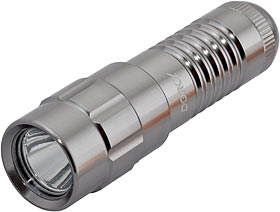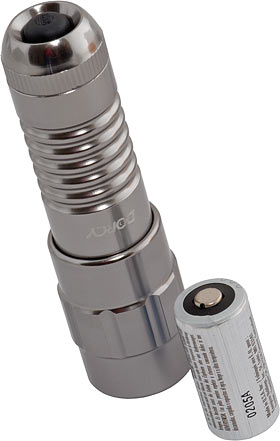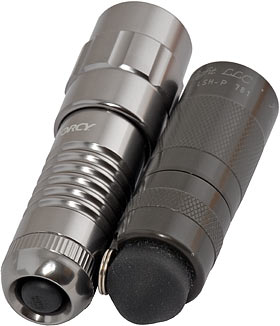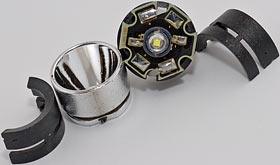
Dorcy 41-4262 LED flashlight
Review date: 13 June 2006. Last modified 03-Dec-2011.
Dorcy have an unfortunate name, but they're a successful purveyor of budget - not in the pejorative sense - flashlights.
Dorcy lights are cheap, straightforward, well-enough-made-for-most-purposes-and-whaddaya-want-for-this-price-anyway. You can find plenty of Dorcy products on sale in supermarkets and auto parts stores, and I bet you've seen them over the years, even if you didn't notice the name.
This, for instance, is a perfectly good basic LED light that I reviewed a few years ago here. It differs only in colour from a light I reviewed in the very early days of commercial white LED flashlights, here.
Dorcy's lights are not necessarily what you'd want to be stuck with after the lurching undead take over the earth - but since Dorcy make various lights that are likely to operate very intermittently if you drop them 20 feet onto concrete while you're skidding down the fire escape in terror after discovering that you're in one of those movies where the zombies are fast, it'll probably be pretty convenient for the plot if you do end up with one of them.
A few of Dorcy's older, cheaper lights need the occasional slap to keep 'em lit even if you've never mistreated them. I reviewed one such a few years ago, here.
But a lot of their stuff is more than solid enough for most users, and cheap enough that normal humans would actually contemplate buying it, too.
Take this, for instance. It's not one of Dorcy's old, dodgy lights.
It's the melodically named 41-4262, and it's got the same basic specs as various "tactical" (a marketing term meant to indicate things used by extremely bad-ass Special Forces types, but which actually usually just seems to mean "black") LED flashlights from a few years ago.
So it's small - about 96mm, or 3.8 inches, in length. It's made from aluminium, so it's light - 79.3 grams (2.8 ounces) with its included battery. That battery's a CR123-type lithium cell, and it powers a one watt "super-LED", activated by a pushbutton switch on the light's tail, and the whole light's got rubber covers and O-rings to make it, if not puddle-proof, at least able to resist an arbitrary amount of rain.
123 cells don't contain much more energy than an ordinary alkaline AA cell, but they deliver it at a nominal three volts (making it easier to drive white LEDs, which all want around 3.6 volts), have less volume and weigh less, and deal with heavy loads much better than an alkaline. They're hysterically expensive if you buy them in camera stores, but cheap enough in bulk, and they've got a ten year shelf life so buying them a dozen at a time is fine.
(They also work fine at very low temperatures; the nominal minimum operating temperature for non-rechargeable lithium cells is minus 40 degrees, where Celsius and Fahrenheit meet up, and slightly below the freezing point of mercury. This, along with the shelf life, means that even if you live in a cold country, you can pretty much count on a lithium-powered emergency flashlight to work any time you need it.)
Most of the little "tactical" lights are quite expensive. The 41-4262 is expensive by Dorcy's standards, but cheap compared with much of its competition; it sells for only thirty bucks US, battery included. That's half of the usual price for a light like this, if not less.
I was, therefore, interested to see in what way the 41-4262 sucked.
Crummy brightness? Poor fit and finish? Crappy durability? Had to be something.
Well, it's a bit bigger than the competition. Part of that is because it's got a modern-style deep reflector lamp, not a plastic lens in front of the power LED. But the whole lamp assembly is a bit deeper than usual even after you take that into account.
There are smooth grip-ridges on the 41-4262's body, and flutes on the head. The ridges have enough bite to be useful, but the flutes are too small to stop the light from rolling away.
(The rubber cover for the power switch sticks out past the end of the light just a little, so the 41-4262 can stand on its tail to light a room by shining on the ceiling, but it isn't very happy about it.)
Using the internationally recognised Sci-Fi Series Design Aesthetic Identification Scale, this flashlight vaguely resembles Yoda's lightsaber, because all single-123-cell flashlights do. Once you get past that, the gunmetal finish and smooth contours make the 41-4262 look like an Enterprise prop.
Which is no bad thing, if you ask me; the show wasn't great, but the sets looked good. I don't remember seeing any obvious Futaba products in Enterprise.
Here the Dorcy light is compared with my old Arc LS, which is about as short as a tailcap-switch single-123-cell light can be. The LS (which has a lens-type lamp, not the Dorcy's deep reflector) is under 80mm in length, a whole 0.63 inches shorter than the Dorcy light.
OK, so maybe the size of the thing doesn't matter all that much.
The pushbutton on the end of the Dorcy is recessed, so it's hard to press it accidentally. That also means it's hard to press it on purpose, though. The standard "tactical" flashlight grip with your fingers curled around it and your thumb on the end is a ticket to the Land of Strain Injuries, as you have to bend your thumb right around to poke it into the end of the switch.
Well, you do until you learn that the switch needs little enough poking that you can do it with the base of your distal phalanx.
So I suppose that's not much of a problem, either.
Um...
Wait! I've got one!
The 41-4262's switch has no "momentary" mode. You can't press it just a bit to turn the light on only while you're holding the switch down. The Dorcy switch, like those in many cheap flashlights, turns on when you press and release it, and it takes considerably less push to do that than it does to turn a momentary-capable switch fully on.
Hm. Maybe that isn't exactly a crippling problem, either.
OK. The beam. Dim, too narrow, uneven and ugly...?
Well, no, not really. The 41-4262 gives you a good "combination" beam, because its reflector lamp lets light from the front of the LED exit directly. There's a bright reasonably narrow middle section, around 12 degrees in width, which is useful for seeing things at medium distances, and there's also quite bright spill light out to about 26 degrees. The full spill beam width, useful when you're shining the light close to see where you're going, is something like 60 degrees - that's wider than usual, despite the narrower than usual centre beam, by the standards of the old lens-lights.
And the Dorcy's beam is all as smooth and pretty and clear and blue-white as an LED flashlight's supposed to be. Cheap incandescent flashlights - and some quite expensive ones, too - have ugly yellow beams with a dark spot in the middle and an impressive ring system further out, all of which make the beam less useful, as well as less pretty. No problem with any of that here.
The Dorcy's not dim, either. At one metre, the realistic average brightness for the central spot is around 580 lux from a new battery, with peaks over 610 lux.
So if you take one lux as being the minimum illumination level that interests you - that's what you get from bright moonlight, and it's the minimum brightness at which you can see any colour - then this light's useful out to about 24 metres, at which distance that one-lux light pool is about five metres wide.
If you're willing to accept only 0.1 lux, which is just enough to see by if you've got normal night vision but haven't been sitting in the dark for a while letting your eyes adjust, then this little light's good for more like 75 metres, with a roughly 16 metre central circle.
The reflector lamp, by the way, also gives you mildly better light output all by itself, because the old-style lenses over an LED eat a non-trivial amount of the light that enters them. All the 41-4262 has is a thin plastic lens on the front of the lamp (flashlight nerds like to apply stick-on treatments to front lenses, or even replace them with glass), and even that is inset far enough into the front of the casing that it ought not get all scratched up and opaque.
All right, all right. So all that stuff's passable too.
The thing must be flimsy, a pain to take apart and impossible to fix, right?
Um, no.
Not really.
Both the lamp and the tail ends unscrew easily, and they both use quality spring contacts that don't bend or "take a set" and stop contacting properly.
(There's also close to zero battery rattle - the 41-4262 clicks slightly if you shake it hard, but otherwise behaves like one solid lump. Attention, cat burglars.)
Like other lights in this class, the 41-4262 has a little electronics module that regulates the voltage from the battery, keeping the lamp brighter for longer at the cost of a bit of battery life.
In this case, the DC-to-DC converter module's in the end of the battery tube; the positive end of the 123 cell butts up against one side of the module, and the lamp's contact spring presses on the other.
("Regulated" lights like this aren't as good as normal LED lights at running for a long time at better-than-nothing brightness when their batteries are very tired. I found the 41-4262 lamp's absolute minimum input voltage to be down around 2.5 volts, as expected for an LED of this type, but if I fed the lamp through the DC-to-DC converter, it lit up quite brightly from only 1.5V. This means you can expect quite consistent brightness for the life of the battery, but no long tail of watch-reading, keyhole-finding brightness at the end.)
You can even take the lamp apart quite easily, and reassemble it too, once you figure out which way round the two black plastic bits go.
Yep, that's a genuine Lumileds Luxeon LED in there, not one of the various knock-off one watt LEDs that're all over the place these days. And the thing's only connected to the rest of the flashlight via a bit of solder, one wire and one neat little bent tab, so you could easily swap in a different LED (with the same power requirements), if the urge struck you.
(Incidentally, an eagle-eyed reader has pointed out to me that the RWOJ binning code printed on the back of the LED's heat sink means this is a desirably high-spec Luxeon.)
This sort of readily-dismantlable design could be a bad thing in a sloppily manufactured light, but the 41-4262 is solid. It doesn't flicker even when it hits the floor, let alone afterward. I dare say you could obliterate the thing somehow, but after looking at it inside and out, I wouldn't worry about breaking it with any amount of normal use.
The only disadvantage to its design that I can see is that it's got rather more unsoldered, uncrimped metal-to-metal contact points in it than usual. Those are not electrically superb, and they'll only get worse as they age and corrode.
Electrons in this light go battery-contact-electronics-contact-contact-LED-casing-switch-contact-battery, whereas electrons in the simplest tail-switch lights go battery-contact-electronics-LED-casing-switch-contact-battery, giving significantly fewer high-resistance contact points.
You'll probably know if you're the kind of person who cares about this. Practically speaking, it's not a big deal - even if you get water inside the light or otherwise badly corrode the contact points, you can pull the thing apart and have at it with a pen eraser to solve the problem.
It's not easy - or, as far as I can see, possible at all - to dismantle the switch and the regulator module without the creative application of violence. But you can't have everything.
(Further nerd reference: If my cheap 'n' cheesy thread gauges are correct, the screw-in tailcap has 18mm diameter and a 1mm metric thread.)
Overall
You know what? This is actually a really neat little light.
Looks good, tough, bright, not hard to find in stores; not even expensive, for what it is.
And it's hackable, too. If you've been looking for a relatively cheap CR123 body to drop a funny-coloured one watt Luxeon Star into, this could well be the one. A blue Star would be a drop-in replacement (because white LEDs are blue ones, with a phosphor layer on top), but you could bodge in different coloured versions with the voltage-dropping current-limiting device of your choice between them and the Dorcy's little DC-to-DC converter puck.
Or, heck, maybe the puck's got current limited output and would work A-OK with any one watt LED. I leave this as an exercise for the reader.
Either way, and especially if you're an ordinary user who just wants a really bright pocket light that doesn't cost the earth and has no intentions of turning it into a turquoise weirdo-light, the humble 41-4262 looks like an excellent choice.
CR123-powered flashlights are very cool things, and make excellent gifts - but a lot of people do not have a long list of people to whom they're keen to give a $US90 gift.
Drop the price to $US30, and the proposition starts looking a lot more sensible.
Recommended.







